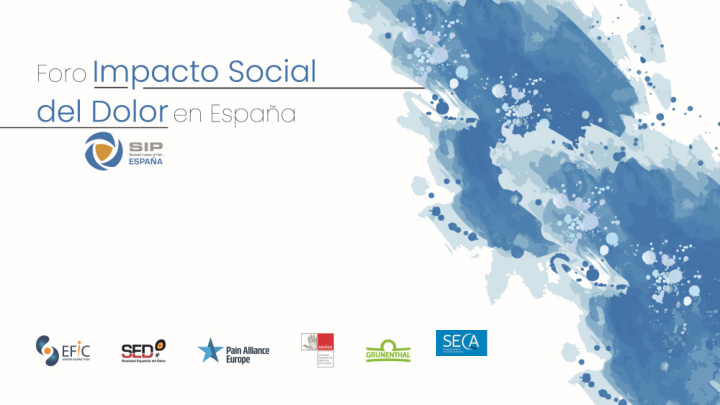



1
SIP History • Societal impact of pain (SIP) is a social platform created in 2009 which supports national stakeholder in developing national platforms • Joint initiative of the European Pain Federation (EFIC) and the pharmaceutical company Grünenthal GmbH • The Platform provides opportunity for discussion for healthcare professionals, pain advocacy groups, politicians, healthcare insurance providers, representatives of health authorities, regulators and budget holders • Main goals • Raise awareness of the impact the pain has on our societies, health and economic systems • Exchange information and share best-practices across all member states of the EU • To develop and foster European-wide policy strategies and activities for an improved pain care in Europe (Pain Policy) 2
Why SIP Spain? • Great support of SIP from Spanish authorities and politicians • The biggest number of SIP Endorser is from Spain , demonstrating high interest in SIP (96 national and regional associations) • Including different levels and profiles with the common goal for a better pain care in Spain • The variability of situations in Spain with different autonomous communities, patient- and political organizations can contribute to develop future regional projects, and involvement in SIP can promote certain stakeholders as decision makers or influencers for this regional initiatives • Supporting and facilitating the inclusion of the different regions is of great importance • Multi-stakeholder approach • Meetings include various speaker and stakeholders to create the best possible content to be attractive to these various roles • Promote regional pain strategies/ plans • Share the need of including a 360º pain management focus on the political agenda • Patient centricity : Give “voice” to the patient 3
Objectives of SIP Spain Generate an awareness forum on the societal impact of pain (SIP) to support exchange of initiatives and new proposals focused on a better pain management with involvement of different profiles and stakeholder levels ( decision makers or influencers) Potential topics Working Groups Focus Pain plans as priority of the • Health politics initiatives WG 1: “POLITICAL” system, with an adequate • Pain as a quality indicator for its assessment Prioritization measurement of initiatives according to opportunities Focus on exchange - best • Protocols or organizational structures WG 2: “TECHNICAL” assessment • Educational and training plans on pain practices sharing after SIP • Specific initiatives for the management of pain in Focus on plans for a specific WG 3: “PATIENT PROFILE” chronic, old, fragile or paediatric patients. interest or patient group • Active patient 4
Event coordination Permanent commission: Scientific societies Patient Associations Management REPRESENTING Steering committee includes: Management REPRESENTING Patient Associations (Quality) 5
Timeline Working with the steering committee in the definition of Event planning and development of contents contents 11 Kick-off meeting • 3 working-groups: • 1 coordinator Selection of speakers/ coordinators/ moderators • 1 moderator • 3 speakers • Each group chooses 3 concrete subjects • Each subject should include the current Selection of attendees situation, good practice examples, suggestions for improvement and political recommendations JUNE JULY- SEPTEMBER OCTOBER NOVEMBER DECEMBER AUGUST 6
Event Program Plenary Sessions at the Ministry of Health Working groups at a Hotel nearby 7
Participants of Groupwork 35 Patient Associations % Stakeholders from regional Health System (Health Care or 25 75 Pharmacy Mgmt.) % participants KOLs – reference for the public system, responsible of pain 40 plans or representative of key scientific societies % 8
Conclusion Groupwork GROUP 1 GROUP 2 GROUP 3 Pain as an indicator of quality of Coordination and continuity of care Attention to pain in chronicity and in care other population profiles Relevance of the systematic measurement Training of HCP is key to ensure a proper Societal impact of pain is higher tan other • • • and assessment of pain , including patient communication as pain is treated by pathologies with more “media presence” – experience (satisfaction) different roles (continuity of pain care) avoid underestimation . • Pain level as key indicator of quality of • Thus, pain should be a institutional • Need to investigate and work on visibility care received objective at all levels of special population groups (chronic, Management of pain should be a strategic Active patient – his/her experience as paediatric) • • element of the health systems measurement of quality and shared • Should be a “must-have” training course decision making for HCP. • Ease the access to pain care – new • “ Pain belongs to everyone ” technologies might be of help • Patients participation in the development of pain care plans and include their experiences 22 29 24 partici partici partici pants pants pants 9
Highlights SIP • The development and formulation of conclusions and recommendations from the Make noise to put pain different working groups during the symposium care in focus • necessary to establish pain as a priority and transversal element in the framework of national health strategies and policies • Unite all organizations and societies advocating better pain care to jointly address, Multi-stakeholder define and foster pain policies or regional initiatives approach • Best practices sharing • An active role of the patient in the management of pain Patient in the center • Improvement of pain management would provide substantial economic and social benefits 10
Impact of SIP in the media Social media impacts #Hashtags 337 posts 100 Total users Reach Tipo de interacción 152160 430737 Impressions 11
Impact of SIP in the media General and specialized media impacts Press Release and video news 31 impacts 4,958,714 Audience 98,416 € ROI (Return on investment 12
THANK YOU VERY MUCH! María Soledad García Penalta PAE Board Member marisol.garcia.penalta@pae-eu.eu 13
Recommend
More recommend